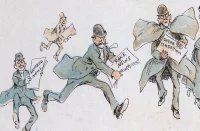Even though the political relationship between the U.S. and Russia has been strained lately, cultural exchanges between the two powers continue. The latest success of Russia’s cultural diplomacy was the performance of Mariinsky’s ballet, Le Corsair, which took place at the Kennedy center from April 9th until April 14th.
This visually stunning ballet opens with a pirate ship desperately trying to navigate the rough seas artistically depicted by waves made of silk, while the stormy night with its hammering rain shows on a transparent screen. The richly decorated vivid costumes, the choreography, and the mesmerizing music together create the atmosphere of the classical Russian ballet known for its harmony and beauty throughout the world. It is no wonder that the ballet has been in the repertoire of the world’s ballet troupes since 1863 since its world premier at the Mariinsky Theater in St. Petersburg. The premier of this particular production took place at the Kirov Theater of Opera and Ballet ,which is known as Mariinsky these days, in 1987.
The plot of Le Corsaire contains all the elements of a great story: love, betrayal, abductions and a happy ending. Following the shipwreck, the sea casts the three men, Conrad, the corsair, and Ali and Birbanto, onto a beach where they encounter a group of young Greek women who come to their rescue. Conrad falls in love with one of the women named Medora. However, the unexpected arrival of the Turkish police changes the course of events – the Turks take the girls to jail after their attempt to hide the corsairs.
Subsequently, the girls are captured by Lenkedem, a slave-trader who sells them at the market, where Said Pasha immediately takes a liking to Medora and is prepared to pay any price for her. Another bidder who is also prepared to pay any price for Medora turned out to be Conrad in disguise. The corsairs manage to rescue Medora , seize Lnkedem the slave trader and flee to the sea. The celebration on shore is short-lived as Conrad is incapacitated by the sleeping potion sprinkled over the bouquet of flowers given to Medora by treacherous Birbanto who agreed to it in exchange for Lankedem’s freedom. Conrad’s shipmates betrayed him as they wanted to keep the other rescued women in spite of their plea to return home. The women are recaptured again and taken to Said Pasha’s harem. Conrad and his men disguise themselves as pilgrims and are able to rescue the girls again. The ballet ends again with the magnificent scene of a very realistic marine scene where the ship takes Conrad, Medora and the friends toward their new happy lives.
 The dancers of the production, both male and female, display an astounding choreography in the tradition of virtuoso classical ballet. The leading female dancer is Maria Khoreva (Medora) whose performance can only be matched by the gravity-defying Ali (Kimin Kim), while Conrad’s solos are less demanding. Kim’s (Ali) performance was superb as the audience gasped every time he performed split jumps and seemed to float on air at times. Kim’s virtuoso technique is on par with the dancing of Rufolf Nureyev or Mikhail Baryshnikov, a comparison excitedly made by several audience members during the intermissions. Khoreva’s pirouettes were also impressive and received frequent ovations from the audience. The ballet corps in Le Corsair is one of the largest found on stage, making the synchronicity of the dances even more remarkable.
The dancers of the production, both male and female, display an astounding choreography in the tradition of virtuoso classical ballet. The leading female dancer is Maria Khoreva (Medora) whose performance can only be matched by the gravity-defying Ali (Kimin Kim), while Conrad’s solos are less demanding. Kim’s (Ali) performance was superb as the audience gasped every time he performed split jumps and seemed to float on air at times. Kim’s virtuoso technique is on par with the dancing of Rufolf Nureyev or Mikhail Baryshnikov, a comparison excitedly made by several audience members during the intermissions. Khoreva’s pirouettes were also impressive and received frequent ovations from the audience. The ballet corps in Le Corsair is one of the largest found on stage, making the synchronicity of the dances even more remarkable.
The ravishing performance of Le Corsair ended with a standing ovation which took longer than usual as if the audience was demanding just one more pirouette or slip jump. Maestro Gergiev’s efforts to turn Mariinsky theater into a major theater of world renown were rewarded in this magnificent ballet production.
Fedor Dostoyevsky said in The Idiot that “Beauty will save the world.” Paraphrasing the famous quote, one can confidently say that “Art will save world,” as art can have no borders, language barriers or political agendas. Washingtonians can only hope to experience the magic of classical Russian ballet again in the years to come.














HURRAH, another success toward Russian/American relations.